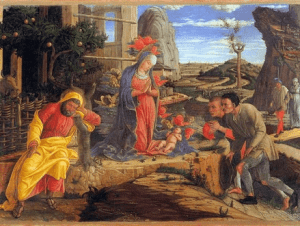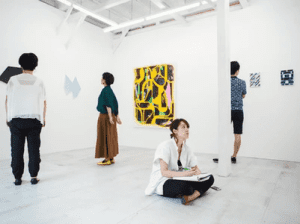Some paintings are beautiful. Some are revolutionary. Édouard Manet’s Le Déjeuner sur l’herbe (The Luncheon on the Grass) is both. When it was first exhibited in 1863, it caused an absolute scandal, shocking the Parisian public and the art establishment to its core. This single canvas is a declaration of artistic independence and is widely considered the starting point of Modern Art.
For any student of art, understanding Le Déjeuner sur l’herbe is crucial. It’s a complex, challenging, and brilliant work that intentionally broke the rules to pave the way for a new kind of painting. Today, it hangs as a treasure in the Musée d’Orsay in Paris, a testament to its enduring power.
A Picnic Scene That Was Anything But Ordinary
At first glance, the painting depicts four figures in a wooded clearing. Two men, dressed as fashionable contemporary dandies, are engaged in conversation. A partially-clad woman wades in a stream in the background. But it’s the fourth figure that caused the uproar: a woman in the foreground who is completely nude, her discarded clothes lying in a heap beside her. And most shockingly of all, she stares directly out of the canvas, meeting the viewer’s gaze with confident self-awareness.
So, Why Was It So Scandalous? 
The 19th-century Parisian Salon was accustomed to nudes, but only under specific, acceptable conditions: they had to be goddesses, nymphs, or figures from history and mythology. They were idealized, timeless, and safely removed from everyday reality. Manet shattered this convention.
1. The Nude Was a Real Woman
The central figure was not Venus or Diana; she was recognizably a contemporary Parisian woman (the model was Victorine Meurent, Manet’s favourite). By placing a modern, un-idealized nude in a casual setting with fully clothed men, Manet erased the line between the classical ideal and the perceived reality of Parisian life. To the public, this didn’t look like a scene from mythology; it looked like a depiction of promiscuous behaviour, and her direct gaze made the viewer feel like a voyeur, complicit in the scene.
2. The Painting Technique Was an Insult to Tradition
Just as radical as the subject was Manet’s style. The academic tradition demanded smooth, carefully blended paint and a perfect illusion of three-dimensional form (chiaroscuro). Manet’s technique was a deliberate rebellion:
Flatness: He painted with broad, flat patches of colour, abandoning the subtle modelling of light and shadow. The nude figure, in particular, is illuminated by a harsh, almost photographic light that flattens her form, making her stand out starkly against the dark background.
Visible Brushwork: The background is painted with loose, visible brushstrokes that seemed unfinished and crude to the Salon jury.
Strange Perspective: The woman in the background is too large in relation to the foreground figures, and the sense of depth feels compressed and unnatural.
To the establishment, it looked less like a finished painting and more like a preparatory sketch. They saw it as an act of defiance, if not outright incompetence.
A Dialogue with the Old Masters 
Manet was not an ignorant painter; he was a master of art history. Le Déjeuner sur l’herbe was a deeply intelligent, and intentionally provocative, update of classical themes. Its composition is directly based on two Renaissance masterpieces:
Titian’s Pastoral Concert (c. 1509): This Venetian masterpiece also features two clothed men with nude female figures in a landscape. By referencing it, Manet was saying, “This was acceptable then; why is my modern version of it so shocking?”
Raphael’s The Judgement of Paris: Manet based the grouping of his three main figures on a section of an engraving by Marcantonio Raimondi, which depicted a work by Raphael.
He was taking a classical arrangement and recasting it in a modern, realist light, forcing the art world to question its own hypocritical standards.
The Salon des Refusés: Birth of the Avant-Garde
As expected, the painting was rejected by the official Paris Salon of 1863. But so many works were rejected that year that Emperor Napoleon III, facing protests from the artists, established the Salon des Refusés (Salon of the Rejected). Here, Manet’s painting became the main attraction. While most of the public came to mock it, it became a rallying cry for a new generation of young, radical artists—including Claude Monet, Camille Pissarro, and Paul Cézanne—who saw Manet as their leader. This event is now seen as the birth of the avant-garde movement.
Key Facts at a Glance
Artist: Édouard Manet (1832–1883)
Title: Le Déjeuner sur l’herbe (The Luncheon on the Grass)
Date: 1863
Style: Realism / Proto-Impressionism
Medium: Oil on canvas
Dimensions: 208 cm × 264.5 cm (81.9 in × 104.1 in)
Location: Musée d’Orsay, Paris, France
Legacy: A New Freedom for Art
Le Déjeuner sur l’herbe is a turning point in art history. It established a new kind of art that was about the artist’s freedom to paint modern life as they saw it, using techniques that broke from academic tradition. It challenged the viewer and declared that a painting could be about ideas as much as it was about beauty. For this, it remains one of the most important paintings ever created.









Responses